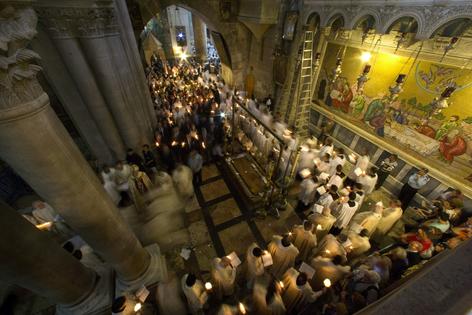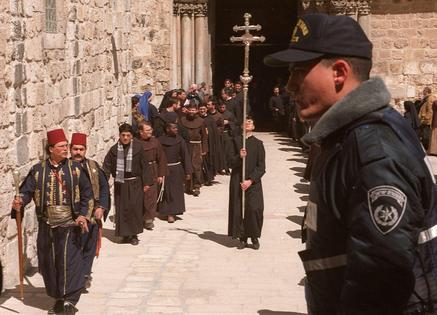Easter 2024 in the Holy Land: a holiday marked by Palestinian Christian sorrow
Published in News & Features
Every year, Christians from across the world visit Jerusalem for Easter week, walking the Via Dolorosa, the path Jesus is said to have walked on the way to his crucifixion over 2,000 years ago. Easter is the holiest of days, and the Church of the Holy Sepulchre, the site where Jesus is believed to have died, is one of the most sacred sites for Christians.
But not all Christians have equal access to these sites. If you are a Christian Palestinian living in the city of Bethlehem or Ramallah hoping to celebrate Easter in Jerusalem, you have to request permission from Israeli authorities well before Christmas – without guarantee that it will be granted. Those were the rules even before Oct. 7, 2023, when Hamas launched an attack on southern Israel. The Israeli response to the Hamas attack has resulted in even more severe restrictions on freedom of movement for Palestinians in the West Bank.
The site where the Bible says Jesus was born, in Bethlehem, and the place he died, in Jerusalem, are only about six miles apart. Google Maps indicates the drive takes about 20 minutes but carries a warning: “This route may cross country borders.” That is because Bethlehem is located in the West Bank, which is under Israeli military occupation, whereas Jerusalem is under direct Israeli control.
As a human rights scholar and Christian Palestinian who grew up in Bethlehem, I have many fond memories of Easter, which is a special time of gathering and celebration for Christian Palestinians. But I also saw firsthand how the military occupation has denied Palestinians basic human rights, including religious rights.
Traditionally, Palestinian families and friends exchange visits, offering coffee, tea and a cookie stuffed with dates called “maamoul,” which is made only at Easter. A favorite tradition, especially for children, is taking a colorfully dyed hard-boiled egg in one hand and cracking it against an egg held by a friend. The breaking of the egg symbolizes the rise of Jesus from the tomb, the end of sorrow and the ultimate defeat of death itself and purification of human sins.
For Orthodox Christians, one of the most sacred rites of the year is the Holy Fire. On the day before Orthodox Easter, thousands of pilgrims and local Christian Palestinians of all denominations gather in the Church of the Holy Sepulchre. Greek and Armenian patriarchs enter the enclosure of the tomb in which Jesus was said to have been buried and pray inside. Those inside have reported that a blue light rises from the stone where Jesus lay, and forms into a flame. The patriarch lights candles from the flame, passing the fire from candle to candle among the thousands assembled in the church.
That same day, delegations representing Eastern Orthodox countries carry the flame in lanterns to their home countries via chartered planes to be presented in cathedrals in time for the Easter service. Palestinians also carry the flame using lanterns to homes and churches in the West Bank.
Palestinian Christians trace their ancestry to the time of Jesus and Christianity’s founding in the region. Many churches and monasteries flourished in Bethlehem, Jerusalem and other Palestinian towns under Byzantine and Roman rule. Throughout this period and into the modern day, Christians, Muslims and Jews lived side by side in the region.
With the Islamic conquest in the seventh century, the majority of Christians gradually converted to Islam. However, the remaining Christian minority persisted in practicing their religion and traditions, including through the rule of the Ottoman empire, from 1516 to 1922, and to the present day.
The establishment of Israel in 1948 led to the expulsion of 750,000 Palestinians, over 80% of the population, which is referred to by Palestinians as the “nakba,” or the catastrophe. Hundreds of thousands became refugees throughout the world, including many Christians.
...continued











Comments